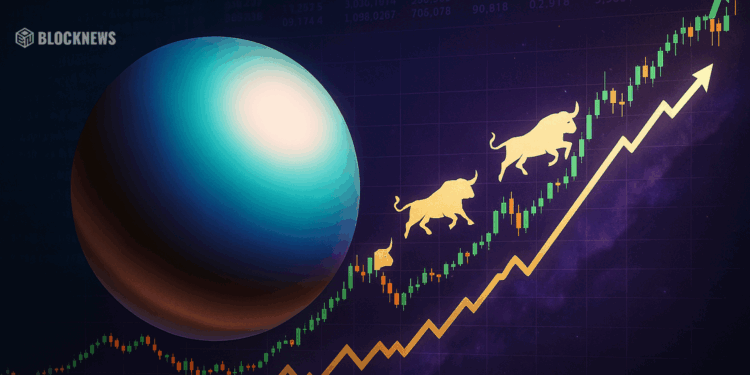- ZORA creator coins: 1.6M+ minted, $500M+ in volume, with royalties baked into every trade.
- Base drives adoption: Coinbase’s L2 is now the top chain for token launches and Web3 culture.
- $ZORA pumps 1,200%: Boosted by Binance listings and real creator demand.
If I told you the hottest money in crypto right now wasn’t coming from Bitcoin, Ethereum, or even the latest memecoin frenzy… would you believe it? Because that’s exactly what’s happening. The biggest moves aren’t coming from the old blue chips—they’re happening in a brand-new wave of creator-driven tokens. And the speed at which this market is growing is honestly insane.
What started as a niche experiment—turning tweets, memes, music, or whatever else into on-chain assets—is quickly becoming one of the most important battlegrounds in crypto. The names driving it? ZORA, a creator-first Layer-2 chain, and Base, Coinbase’s fast-growing L2 that’s turning into the home for token launches. Together, they’re fueling a token-creation frenzy that has already outpaced Solana. And for those paying attention, this shift might just redefine how value moves online.
ZORA: The Creator Chain That Pays You Back
Unlike most blockchains, ZORA isn’t trying to be everything for everyone. It’s a creator-first Ethereum Layer-2, built on the Optimism OP Stack, and its mission is simple: let anyone mint content directly on-chain. No middlemen, no ad revenue hoops—just direct monetization. Memes, music, digital art, viral posts… if it gets attention, it can be tokenized.
The clever twist is ZORA’s creator coin system. Each creator gets a fixed supply coin—half unlocked right away, half vesting over five years. And here’s the kicker: every trade of that coin sends 1% straight to the creator. Not just at launch—forever. It’s like royalties baked into the blockchain itself.
And the numbers? Wild. Since July, over 1.6 million creator coins have been minted, pulling in more than 3 million traders and generating nearly half a billion dollars in volume. On some days, ZORA has seen over 54,000 new tokens launched—double Solana’s daily count. That’s not “decent for a new chain”—that’s dominance.
Base: Coinbase’s Trojan Horse for Mass Adoption
Then there’s Base—the engine making this explosion possible. Base is Coinbase’s Ethereum Layer-2, also running on Optimism’s stack, and it’s built with one thing most other chains don’t have: distribution. It’s plugged directly into Coinbase’s ecosystem, meaning millions of users can hop onto Base without needing to fumble with bridges or complicated onboarding.
In the past month, Base has quietly become the top chain for token launches. We’re talking tens of thousands of new tokens minted daily, fueled by projects like ZORA. And this isn’t just noise—this is liquidity, volume, and entire micro-communities forming overnight. From memecoins and creator coins to social finance experiments, Base is becoming a cultural hub more than just another Layer-2.
And don’t underestimate the “legitimacy factor.” With Coinbase backing it, regulators and institutions are far less likely to push back against Base compared to other networks. It’s cheap, fast, and easy to use—making it the perfect breeding ground for what comes next.
Why $ZORA Is Pumping Like Crazy
The $ZORA token hasn’t just been running—it’s been ripping. In the last month alone, it’s up over 1,200%, hitting highs near $0.15 before pulling back slightly. That’s the kind of parabolic run you usually see in memecoins, not in projects with real infrastructure behind them.
Part of the pump came from Binance listing ZORA perpetual contracts with up to 50× leverage. That unleashed a flood of speculative money and drove liquidity higher. But the fundamentals are moving too—tens of thousands of creator coins minted daily, whales quietly stacking, and exchange listings piling up.
Right now, $ZORA is hovering around $0.12, bouncing between $0.11 and $0.15 intraday. Volatile, yes—but that’s crypto. And the difference this time is that behind the hype, there’s real activity pushing the ecosystem forward.
The Road Ahead: Social Layers, Partnerships, and Expansion
ZORA isn’t slowing down. The next phase is all about building community tools—exclusive drops, gated chats, and perks for coin holders. The goal is to turn each coin into more than just a speculative asset; they want micro-economies built around creators.
There are also whispers of big partnerships brewing—music labels, influencers, even sports brands looking at launching their own creator tokens. If that happens, we’re not just talking about crypto-native adoption anymore. This could be the funnel that finally brings mainstream audiences into Web3—without them even realizing it.
And with Base providing cheap, fast rails, the infrastructure is already set. Every new creator, every new micro-community, feeds back into both ecosystems, driving more volume and more liquidity.
Should You Buy $ZORA?
Here’s the tough part. $ZORA’s up over 10x in just weeks. That kind of run makes everyone feel like they’re missing out, but it also means volatility is brutal. The fundamentals—creator adoption, Base integration, exchange listings—are strong. But short-term moves are still driven by speculation and leverage.
If you’re looking long term, the case is clear: ZORA has a real niche (creator monetization), actual adoption, and momentum. If they can keep expanding beyond crypto-native circles and land mainstream deals, it could be a genuine game-changer. But jumping in after a 10x pump carries obvious risk. Timing matters.
Final Thoughts: A New Internet Economy?
The story of ZORA and Base isn’t just about another hot token pump. It’s about a shift in how value flows online. Instead of likes, views, or ad impressions, creators are minting attention into liquid markets. Fans are becoming investors, traders are becoming community members, and blockchains are becoming cultural engines.
It feels like one of those rare “before and after” moments in crypto. Whether $ZORA keeps ripping or cools off, the bigger picture is clear—on-chain culture is going mainstream, and Base is turning into its launchpad.
The question isn’t if this trend will grow—it’s how fast. And if history’s any guide, the answer might be: a lot faster than people expect.














